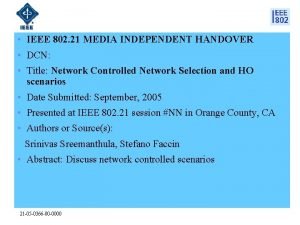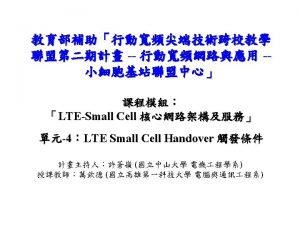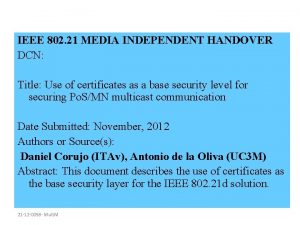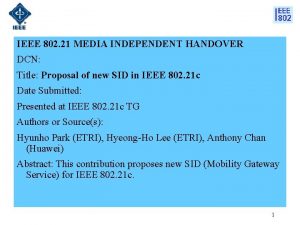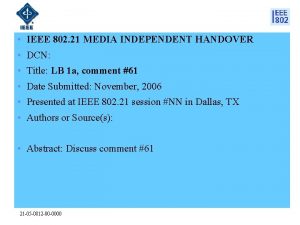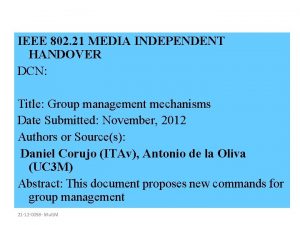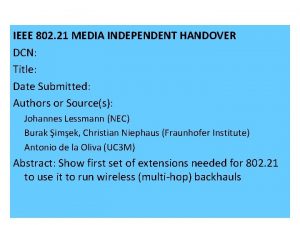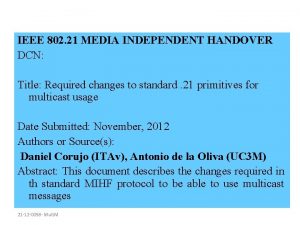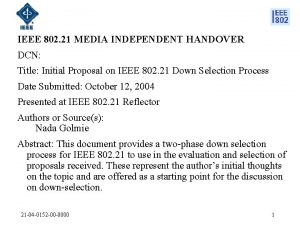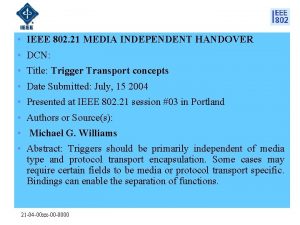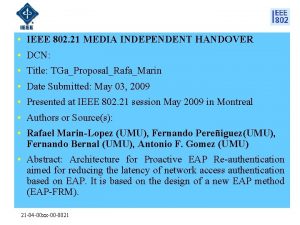IEEE 802 21 MEDIA INDEPENDENT HANDOVER DCN Title












- Slides: 12

• IEEE 802. 21 MEDIA INDEPENDENT HANDOVER • DCN: • Title: Network Controlled Network Selection and HO scenarios • Date Submitted: September, 2005 • Presented at IEEE 802. 21 session #NN in Orange County, CA • Authors or Source(s): Srinivas Sreemanthula, Stefano Faccin • Abstract: Discuss network controlled scenarios 21 -05 -0366 -00 -0000

IEEE 802. 21 presentation release statements • This document has been prepared to assist the IEEE 802. 21 Working Group. It is offered as a basis for discussion and is not binding on the contributing • • individual(s) or organization(s). The material in this document is subject to change in form and content after further study. The contributor(s) reserve(s) the right to add, amend or withdraw material contained herein. The contributor grants a free, irrevocable license to the IEEE to incorporate material contained in this contribution, and any modifications thereof, in the creation of an IEEE Standards publication; to copyright in the IEEE’s name any IEEE Standards publication even though it may include portions of this contribution; and at the IEEE’s sole discretion to permit others to reproduce in whole or in part the resulting IEEE Standards publication. The contributor also acknowledges and accepts that this contribution may be made public by IEEE 802. 21. The contributor is familiar with IEEE patent policy, as outlined in Section 6. 3 of the IEEE-SA Standards Board Operations Manual <http: //standards. ieee. org/guides/opman/sect 6. html#6. 3> and in Understanding Patent Issues During IEEE Standards Development http: //standards. ieee. org/board/pat/guide. html> 21 -05 -0366 -00 -0000

Introduction • 802. 21 aids in inter-technology handover with various usage scenarios in mind • It is also important for 802. 21 to provide tools for cellular and other operators to exercise network control to inter-work and maximize the resource pool in other access networks • This slide set presents network controlled usage scenarios for Inter -technology network selection and HO control as a means to understand the importance of such use cases • This is for informational purposes only that can be used to verify these scenarios are indeed covered under 802. 21 21 -05 -0366 -00 -0000

802. 21 @ L 2 vs. 802. 21 @ L 3 (cont. d) • @ L 3 and above: • • • Applicable only to current access Use existing IP connectivity to access and MIHF in the network (see scenarios below) Effort to define 802. 21 transport @ L 3 and above has started in IETF (MIPSHOP WG being re-chartered, new WG co-chair selected for this purpose – yours truly) Advantage of L 3 and above is that it can be deployed independently of standardization status in 802. 11 and 802. 16, and before operators deploy updated APs Also, not clear whether 802. 11 and 802. 16 will implement ES and CS use L 3 for ES and CS MIHFNW MIHFUE UE 802. 21 transported @ L 3 or above GERAN/ UTRAN IP 3 G-PDN In scope o 802. 21/IE MIHFNW MIHFUE UE UE MIHFNW IP 802. 11 -AN MIHFNW MIHFUE 21 -05 -0366 -00 -0000 MIHFNW 802. 16 -AN Wi. MAX PDN MIHFNW IP

802. 21 vs Current 3 GPP Mechanisms • Access Control/ Network selection: • Currently core functionality of 3 GPP networks • It is interest of several 3 GPP parties in keeping access control between 3 GPP (access) networks under control of 3 GPP • This can be achieved while introducing enablers for seamless inter-technology mobility • 802. 21 focuses only on heterogeneous handoff (I. e. inter-technology handoff in 802. 21 terminology, e. g. 3 GPP-802. 11, 802. 11 -802. 16, etc. ) • • The only intra-technology handoff in scope is inter-subnet/inter-domain handoff for 802. 11, simply because 802. 11 does not define it 3 GPP/PP 2 and 802. 16 have their own access selection mechanisms for homogeneous handoff, and 802. 21 does not intend to interfere with that • 3 GPP-WLAN IW: current Network Selection mechanisms • Based on policies and information stored in UE (SIM) • Based on information collected from UE • Network has no active role at moment of selection • Issue: cumbersome mechanism, requires connecting to a network to decide whether to connect to the network • IEEE is addressing this issue in 802. 11 TGu and 802. 21 (through IS) to enable simpler network selection 21 -05 -0366 -00 -0000

802. 21 Usage Scenarios for 3 GPP • A set of example “access system selection” scenarios to describe what can be achieved with 802. 21 • Scenarios split between two dimensions • 802. 21 service • • Information Service Event/Command Service • Terminology • 3 G-PDN: indicates the whole network (including AN and core network, i. e. up to point where UE gets IP connectivity) • MME: Mobility Management Entity • • It’s a network entity sitting “above” current 3 GPP access (e. g. located “after” the ISN) in charge of making connectivity decision for network controlled handoff. MME incorporate an instance of MIHF 21 -05 -0366 -00 -0000

Usage Scenarios for 3 G Cellular Network -> IEEE 802. x Scenario-A: 3 G network is MIH unaware • Scenario-A) MIH unaware serving network (3 G), • Emphasis is on enabling network handoff control by home network or third party (e. g. enterprise) • Examples are • • Visited 3 G network not 802. 21 aware (no 802. 21 specific functions in 3 G network) Visited 3 G network has no active control over vertical HO decisions • Home network or 3 rd party controls the network selection and HO decisions (IS, ES and CS used) “Home” Network Access to MIHF (ES/CS) over L 3 Internet Visited 3 G-PDN MIHFNW Access to MIHF (IS) over L 3 MIHFNW UTRAN GERAN 802. 11 -AN Current active connection MIHFUE UE 21 -05 -0366 -00 -0000 MIHFNW 802. 16 -AN Wi. MAX PDN

Usage Scenarios for 3 G Cellular Network -> IEEE 802. x Scenario-B: 3 G network is MIH aware, provides IS, ES & CS • Scenario-B) MIH services provided by serving network (3 G), • Emphasis is on enabling network handoff control by network operator (e. g. home) to target access owned by the same operator • Examples are • • • Operator owning multiple access technologies and user belongs to this network Operator has roaming agreements to cover multiple accesses for users from other networks 3 G network can control network selection and HO decisions (MME – Mobility Management Entity, e. g. can sit in ISN) Internet MIHFNW Home 3 G-PDN UTRAN Access to MIHF over L 3 GERAN 802. 11 -AN Current active connection MIHFUE 21 -05 -0366 -00 -0000 MME UE 802. 16 -AN Wi. MAX PDN Note: MIHF can be physically implemented as a set of MIHF. MME can be more or less centralized

Usage Scenarios for 3 G Cellular Network -> IEEE 802. x Scenario-C: 3 G network proxies MIH IS services, provides ES and CS • Scenario-C) MIH IS services proxied by serving network (3 G) • Emphasis is on enabling network handoff control by network operator (e. g. home) to target accessed owned by roaming partners • Proxy is to access IS from other networks • Examples are • • • Operator has no agreements to cover multiple accesses for other users Operator has no agreements to cover a particular access that user sees and user is personally responsible for the access 3 G network controls vertical HO decisions Internet MIHFNW Home 3 G-PDN Access to MIHF IS over L 3 MIHFNW UTRAN GERAN 802. 11 -AN Current active connection Access to MIHF IS , ES and CS over L 3 21 -05 -0366 -00 -0000 MIHFUE UE MIHFNW 802. 16 -AN Wi. MAX PDN

NW Initiated NW Selection for Scenario-B 3 G->802. x: 3 G provides all MIH services Network Operator UE IP-Mobility Conn. Mgr MIHFUE MAC Layers 3 G-PDN MIHFNW MME MIHFNW(IS) UE Discovery and attachment MIH-Register-Events. Resp MIH-Register-Event. Req() MIH-Register-Events. Req MIH-Register-Event. Resp() MIH-Register-Events. Resp DL-Burst* Link-Detect Link-Event. Detect(link_info) MIH-Info. Req MIH-Info. Resp Scan(802. 11) Link-Detect Unfavorable Network Beacon Link-Event. Detect(link_info) MIH-Info. Req MIH-Info. Resp 21 -05 -0366 -00 -0000 Favorable Network => Selection 802. 16 -AN 802. 11

NW Initiated NW Selection for Scenario-C 3 G->802. x: 3 G provides ES/CS services and can proxy IS services Network Operator UE IP-Mobility MIH user MIHFUE MAC Layers 3 G-PDN MIHFNW MME 802. 16 Network MIHFNW(IS) 802. 16 -AN MIHFNW(IS) 802. 11 Network 802. 11 -AN MIHFNW(IS) UE Discovery and attachment MIH-Register-Events. Resp MIH-Register-Event. Req() Proxying: MME in operator network queries the MIHF in other networks based on the report from the UE. MIH-Register-Events. Req MIH-Register-Event. Resp() MIH-Register-Events. Resp DL-Burst* Link-Detect Link-Event. Detect(link_info) Just one Link Event may be generated, reporting both events MIH-Link-Event. Detect(link_info) Beacon Link-Detect Link-Event. Detect(link_info) MIH-Info. Req MIH-Info-Req() MIH-Info-Resp(nwk_info) MIH-Info-Req() MIH-Info. Resp 21 -05 -0366 -00 -0000 Favorable Network => Selection MIH-Info-Resp(nwk_info)

NW Controlled HO for Scenarios B&C 3 G ->802. x. HO Control in 3 G with MIH ES/CS services Operator Network UE Mobile-IP MIH User MIHFUE 3 G-MM 802. 11 MAC 3 G-PDN MIHFNW MME 802. 11 Network 802. 11 -AN New-FA HA Previously happened Network Selection MIH-Link-Switch. Req(802. 11 nwk) MIH-Remote-Link-Switch. Req(802. 11 nwk) L 3 -switch. Ind MIP-switch. Ind MIH-switch. req Link-Associate Legenda Mobile-IP Tunneling Mobile-IP Signaling Non-MIH (I. e. Implementation dependent) L 2 -Procedures (Security, Re-association, Qo. S Neg. ) Link-Event-Up(802. 11 nwk) MIH-Link-Event-Up Link-up. ind Registration-Req Registration-Resp L 2 -PDP-Cntxt-Rel(3 G GMM) 3 G-PDP-Rel() Link-Event-Down(3 G) MIH-Link-Event-Down MIH-switch. resp MIH-Remote-Link-Switch. Resp MIH-Link-Switch. Resp(802. 11 nwk) 21 -05 -0366 -00 -0000


